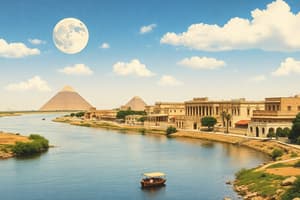Podcast
Questions and Answers
What is one significant artifact that supports the existence and legacy of Narmer?
What is one significant artifact that supports the existence and legacy of Narmer?
The Narmer Palette is a significant artifact depicting the unification of Egypt.
Who were the three Egyptian kings considered as potential candidates for the legendary figure Menes?
Who were the three Egyptian kings considered as potential candidates for the legendary figure Menes?
The three kings are Hor-Aha, Scorpion, and Narmer.
What crowns did Narmer wear to symbolize the unification of Upper and Lower Egypt?
What crowns did Narmer wear to symbolize the unification of Upper and Lower Egypt?
Narmer wore the white crown of Upper Egypt and the red crown of Lower Egypt.
What was the new capital founded after the unification of Egypt and when did Narmer reign?
What was the new capital founded after the unification of Egypt and when did Narmer reign?
During which period did Narmer become the first king, and what followed this era?
During which period did Narmer become the first king, and what followed this era?
How did the Nile's regular flooding influence the agricultural practices of ancient Egyptians?
How did the Nile's regular flooding influence the agricultural practices of ancient Egyptians?
What significance did farming have on the identity of ancient Egyptians?
What significance did farming have on the identity of ancient Egyptians?
In what ways did the geography of Egypt serve as a natural defense against invasions?
In what ways did the geography of Egypt serve as a natural defense against invasions?
What role did the Nile play in the economic resources of ancient Egypt?
What role did the Nile play in the economic resources of ancient Egypt?
How did the multicultural makeup of Lower Egypt impact its development compared to Upper Egypt?
How did the multicultural makeup of Lower Egypt impact its development compared to Upper Egypt?
What challenges did maritime attackers face when trying to invade Egypt via the Mediterranean?
What challenges did maritime attackers face when trying to invade Egypt via the Mediterranean?
Discuss the importance of the Nile's consistent travel routes for ancient Egyptian society.
Discuss the importance of the Nile's consistent travel routes for ancient Egyptian society.
How did the fertile land of Lower Egypt affect its interactions with Nubia?
How did the fertile land of Lower Egypt affect its interactions with Nubia?
What role did the Nile's low salinity play in Egyptian agriculture?
What role did the Nile's low salinity play in Egyptian agriculture?
How did the natural defenses of Egypt discourage invasions?
How did the natural defenses of Egypt discourage invasions?
What natural resources contributed to Egypt's wealth?
What natural resources contributed to Egypt's wealth?
Describe the political structure of Egypt during the pre-dynastic period.
Describe the political structure of Egypt during the pre-dynastic period.
Who is credited with the unification of Upper and Lower Egypt, and what does his name signify?
Who is credited with the unification of Upper and Lower Egypt, and what does his name signify?
What advantages did the flat elevation alongside the Nile provide for Egyptians?
What advantages did the flat elevation alongside the Nile provide for Egyptians?
How did the geography of the Sinai Peninsula impact military movements?
How did the geography of the Sinai Peninsula impact military movements?
What role did papyrus play in ancient Egyptian society?
What role did papyrus play in ancient Egyptian society?
Flashcards are hidden until you start studying
Study Notes
Geography
- The Nile River is central to Egyptian life and worldview.
- The Nile flooded predictably every year, creating a regular cycle of flood, plant, and harvest.
- People settled along the river, farming the fertile soil.
- Deserts surround both sides of the Nile, protecting Egypt from invasion.
- The Nile was worshipped as a god for providing life.
- Most of Egypt's historical events and developments occurred in Lower Egypt, around the Nile delta.
- Upper Egypt developed later, gaining importance when Theban pharaohs rose to power.
- Travel along the Nile was consistent, with Egyptians traveling north on the current towards the sea and south with winds off the Mediterranean.
- Egypt's unique society developed due to geographic isolation.
Natural Protection
- The Nile Delta hinders effective sea-bound enemy offensives.
- Egyptians could ambush invaders from the Delta using islands.
- Attacking from the Mediterranean would mean moving against the current.
Natural Resources
- Egyptians mined gold and copper around Mount Sinai, later becoming rich from Nubian gold.
- Nile mud was used to create clay jars and pots.
- Fish were abundant in the Nile and Mediterranean.
- Papyrus reeds were used for boats, baskets, sandals, and writing scrolls.
Early Egyptians
- Egypt's name comes from a mispronunciation/evolution of "hout-ak-Ptah" or "house of Ptah."
- Egyptians called themselves remet-en-kemet, "people of the black soil," highlighting the importance of farming to their identity.
- By the time Lower Egypt developed, its population was a diverse mix of ethnicities.
- Egyptians were descendants of Asiatic ("Arabic") nomads and African tribal groups.
- Asian ancestors followed gazelle herds from the east, crossing the Sinai Peninsula and finding fertile land.
- Asian settlers mixed with their southern neighbors (Upper Egypt, Nubia), who were experimenting with farming.
- Lower Egypt's fertility allowed its people to advance beyond the Nubians, who were slowly expanding north.
- When the two societies met, Lower Egypt was more populous and technologically advanced due to its fertile land.
Development of Egypt
- The Nile's length resulted in different political systems during the pre-dynastic period.
- Villages grew into cities, concentrating populations.
- Cities transitioned into provinces called nomes, with 20 in Lower Egypt and 22 in Upper Egypt.
- Warrior-nobles initially ruled these nomes, eventually leading to each Egypt having its own king.
- Between 3200 and 2780 BCE, Upper and Lower Egypt unified under a mysterious individual.
Unification of Egypt
- Menes is credited with uniting Upper and Lower Egypt according to ancient tradition.
- Different historical sources refer to him as Menes, Min, or Meni.
- "Menes" might have been an epithet or title, concealing his true name.
- Egyptian legend claims Menes was the first human king, appointed by the god Horus.
- Archaeological evidence about Menes is scarce.
- Egyptologists debate the existence and identity of Menes, considering three possible real kings: Hor-Aha, Scorpion, and Narmer.
- Narmer appears the most likely candidate, with substantial archaeological evidence, including the Narmer Palette.
Narmer Palette
- Dated to around the 31st century BCE.
- Contains some of the earliest hieroglyphic inscriptions ever found.
- Depicts Narmer wearing the white crown of Upper Egypt on one side and the red crown of Lower Egypt on the other.
- After Narmer, kings wore the double crown of Upper and Lower Egypt.
Early Dynastic Period
- Egypt's unification may have been spread across several kings' reigns.
- A new capital was founded in Memphis, near modern-day Cairo, after unification.
- Narmer was the first king of the Early Dynastic Period (c. 3150 BCE – 2686 BCE).
- The Old Kingdom, the age of the pyramids, followed this era.
Studying That Suits You
Use AI to generate personalized quizzes and flashcards to suit your learning preferences.




